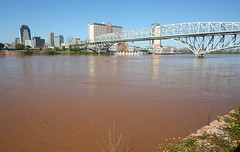The American rivers were still difficult to navigate, however, because of the presence of dead wood called snags, sawyers [1], or log jams, says Wikipedia.
Henry Miller Shreve was appointed Superintendent of Western River Improvements in 1826 and charged with finding a solution to this problem. He had been working on a design for a "snagboat" since 1821, and he finally had it built in 1827. This craft, the Heliopolis, had a steam-powered windlass used to pull large concentrations of dead wood from the water. As a result of the success of his design, Shreve was ordered in 1832 by Secretary of War Lewis Cass to clear the Great Raft, 150 miles of dead wood on the Red River.
Shreve successfully removed the Raft (despite inadequate funding) by 1839. The area of the Red River where the Raft was most concentrated is today his namesake city of Shreveport. Shreve helped to establish Shreveport via the Shreve Town Company. In 1841, Shreve was relieved of his superintendent's duties by the nominally Whig U.S. President John Tyler. He hence retired to his farm near St. Louis.
Tuesday, August 19, 2008
Subscribe to:
Post Comments (Atom)


No comments:
Post a Comment